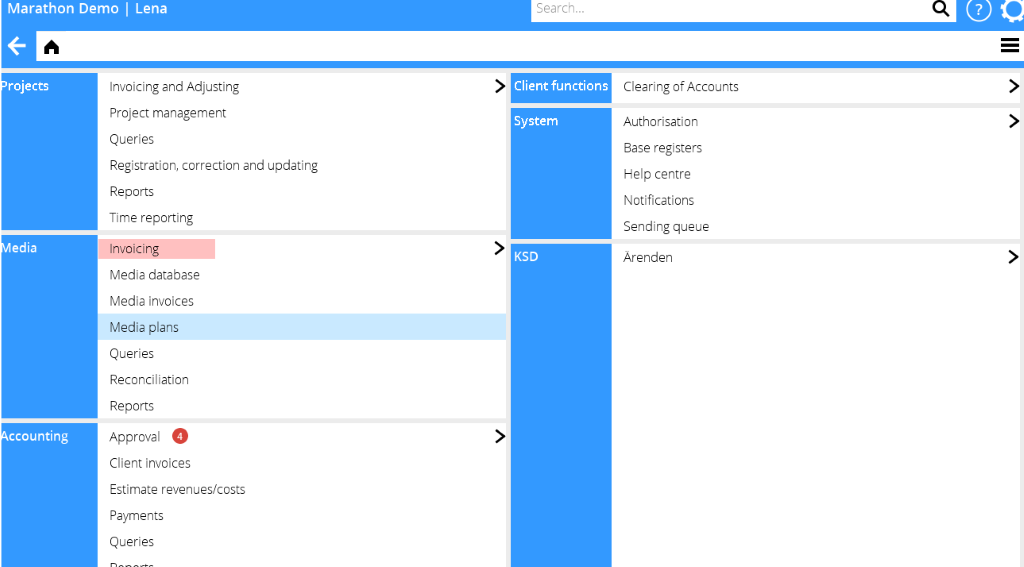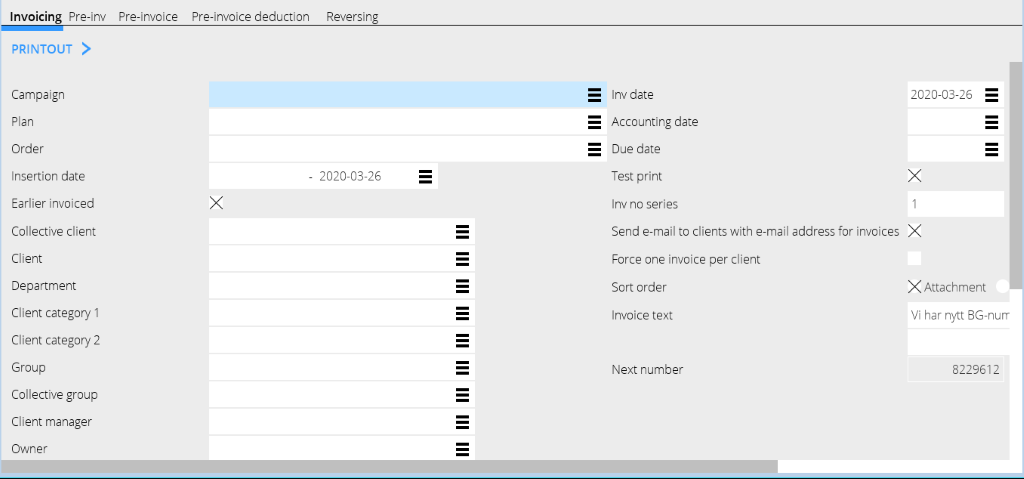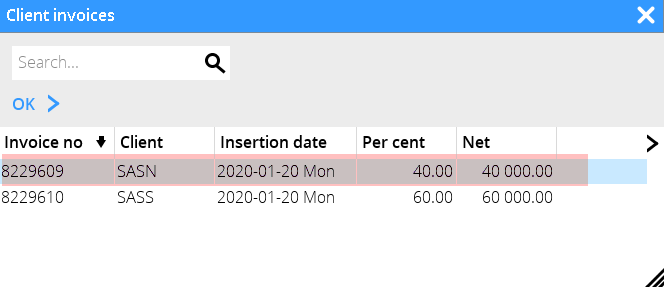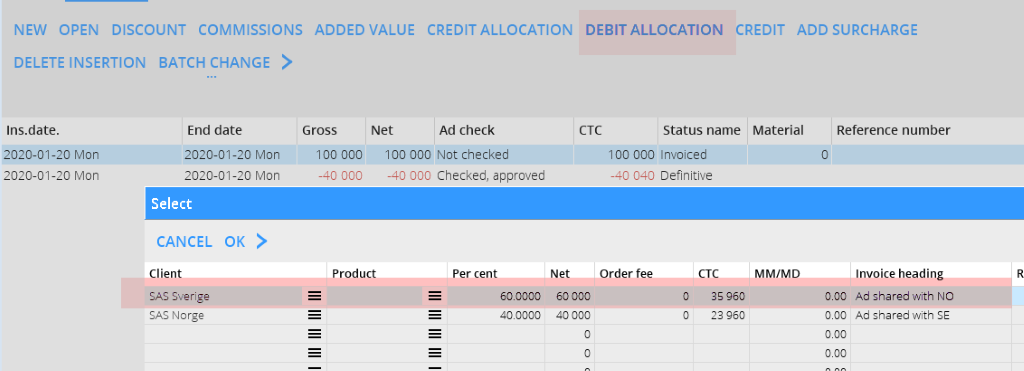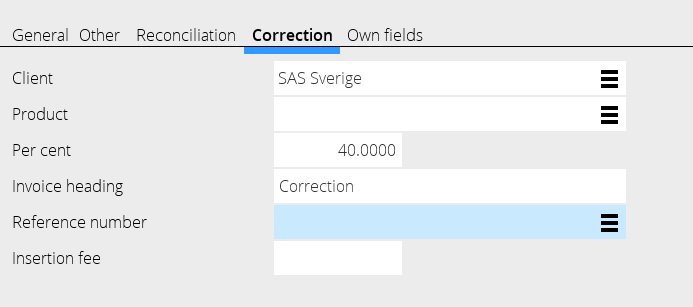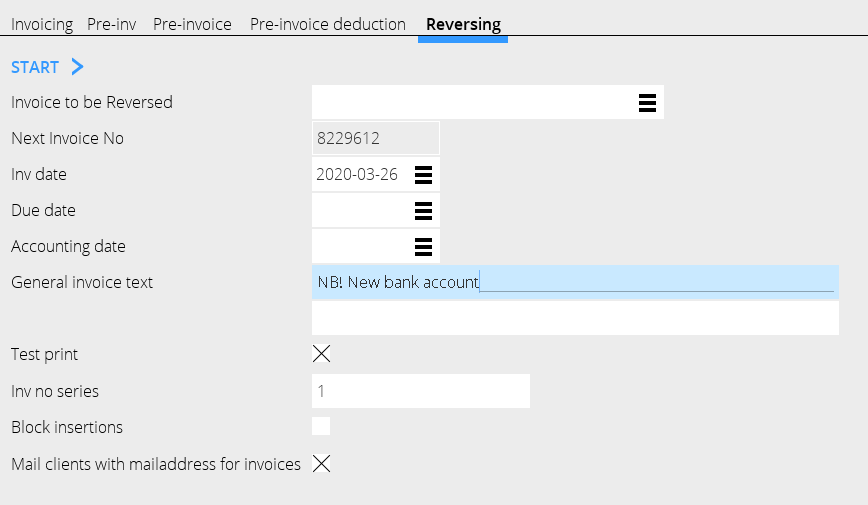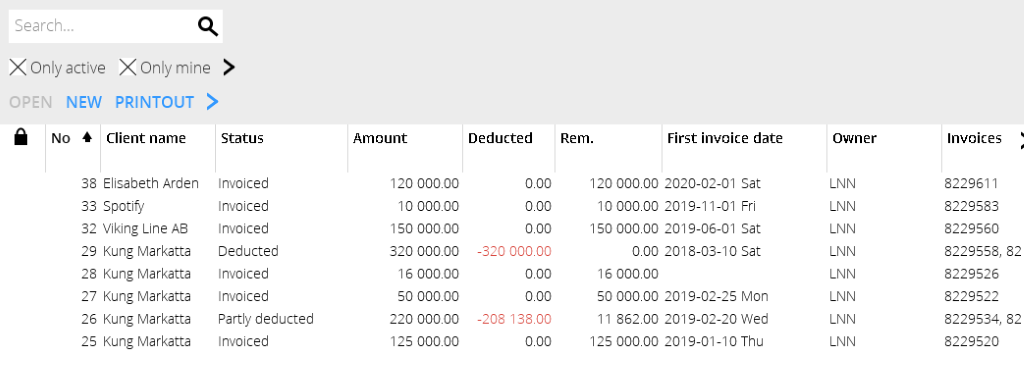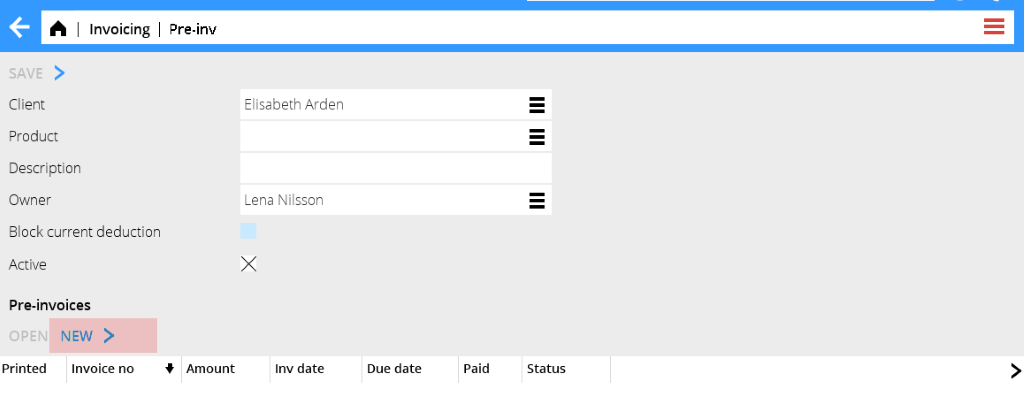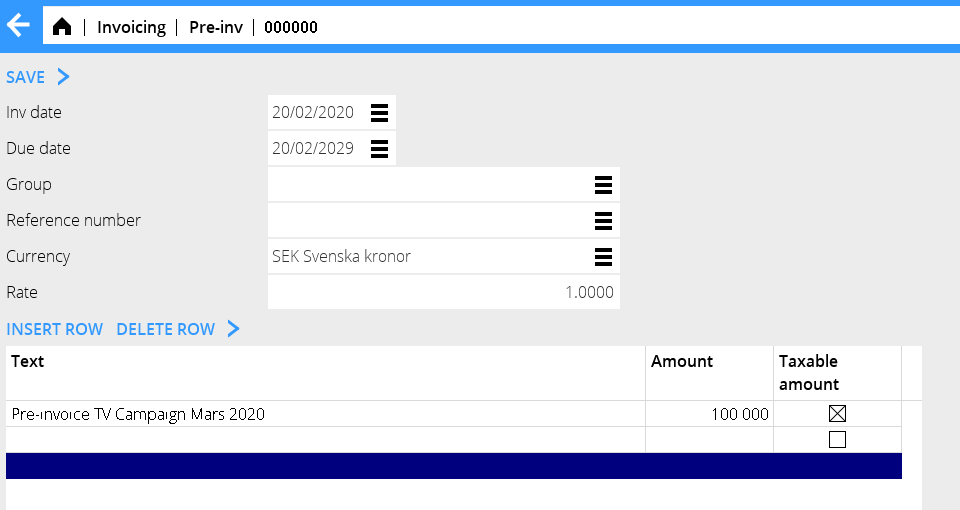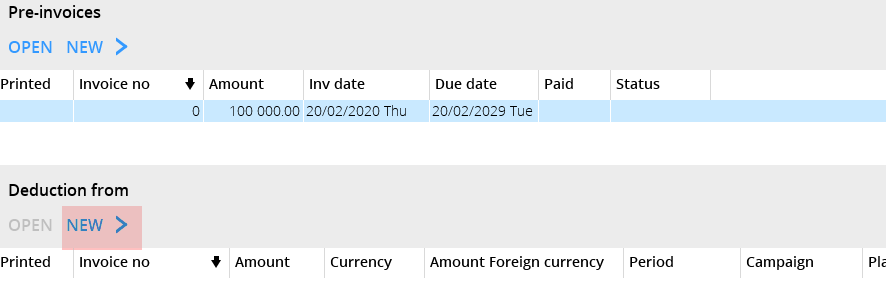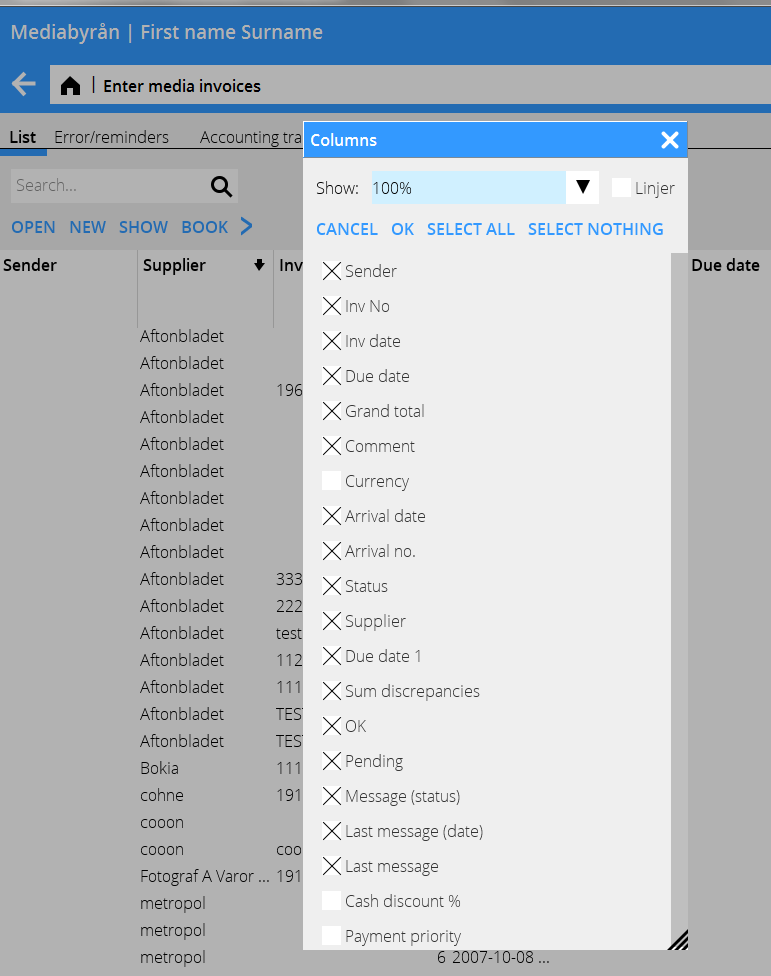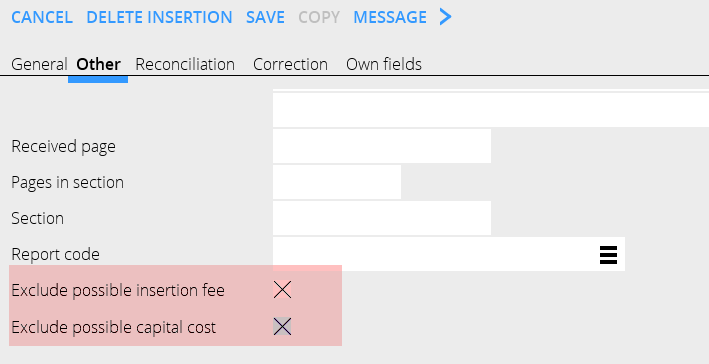Difference between revisions of "Media accounting/nb"
(Created page with "Bruk listen i 08-70-26 for å se nåværende avregningsstatus. Velg J på Detaljer.") |
(Created page with "= Differanser/Avstemming av differanser =") |
||
| Line 143: | Line 143: | ||
Bruk listen i 08-70-26 for å se nåværende avregningsstatus. Velg J på Detaljer. |
Bruk listen i 08-70-26 for å se nåværende avregningsstatus. Velg J på Detaljer. |
||
| + | = Differanser/Avstemming av differanser = |
||
| − | = Reconciliation of discrepancies/ Discrepancies = |
||
Book away discrepancies in Media: Reconciliation. |
Book away discrepancies in Media: Reconciliation. |
||
Revision as of 09:56, 8 August 2017
Contents
Fakturering
Fakturering gjøres i 08-70-10.
Utvalg kan gjøres på innrykksdato, budsjettnummer, kunder, kundekategorier, osv.
| Løpende fakt | Hvis blank, vises alt uansett innstillinger i avtalen. Hvis du kun vil fakturere avtaler med løpende fakturering, skriv J. |
|---|---|
| Også ikke ktrl | J= også ikke kontrollerte innrykk vises, forutsatt at budsjett- eller ordrenummer har angitts. |
| Ref nr savnes | N= ordrer med referansenummer vil faktureres, forutsatt at parameteren Fakturer kun ordrer med referansenummer er aktivert. |
Y= alle planer/budsjetter med blank referanse faktureres, til tross av eventuell innstilling om obligatorisk referansenummer.
Blank= Alt vises, men bare i testutskrift.
Hvis parameteren ”Fakturer kun ordrer med referansenummer” er aktivert i kunderegistret, må dette felt være satt til J. Dersom du inntaster en feilaktig kombinasjon, viser systemet en feilmelding og du kan ikke fortsette å fakturere
| Debet/Kredit | 0 = alt faktureres.1 = kun debetnotaer 2 = kun kreditnotaer. S = debet- og kreditnotaer på separate fakturaer. |
|---|---|
| Korrigeringer | Marked invoices (x) can be invoiced separately. J = include corrections N = do not include corrections S = invoice ordinary and corrections an separate invoices |
| Tvinge frem en faktura pr kunde | Y= styr over kunden sin minimumgrense for fakturering. |
Hvis du vil skrive noe på fakturaen, bruk Generell fakturatekst. Tekst som skal være på fakturaen en lengre tid må skrives inn i 08-70-11.
Krediter/vend en faktura
Dersom hele fakturaen er feil, kan den krediteres i Classic 08-70-12.
| Ikke fakturer innrykk | Alle innrykk blokkeres fra faktureringen da fakturaen krediteres. N= innrykkene blir definitive og kan korrigeres og faktureres på nyt. |
|---|---|
| Eposte kunder… | Foraldret funksjon. Bruk Fakturadistribusjon i Økonomi: Fakturadistribusjon. |
Kreditere/vend innrykk
Åpn ordre og innrykk. Velg innrykket som må krediteres og tast Krediter.
Innrykket blir vendt, dvs. vises som ett kreditinnrykk og markert som en korrigering. Det betyder at du kan fakturere den separat i den løpende faktureringen.
Dersom du vil kreditere innrykk uten at ta med gebyrer og kapitalkostnad, kan du velge å ekskludere dem
Det gjør du i innrykket, i fliken Annet
Kreditere/vend del av fordeling
| Eksempel: |
|---|
Kunden SAS Norway må krediteres, i stedet skal SAS Sweden debiteres.
1. Åpn ordren og velg innrykket, som må korrigeres. Tast Krediter fordeling.
2. Velg fakturaen som må debiteres. Tast OK.
3. Velg innrykket som må debiteres (det opprinnelige innrykket, ikke kreditinnrykket).
Tast Debiter fordeling
5. Velg posten, som skal debiteres på nyt of tast OK.
6. Velg det nye debetinnrykket og åpn det. Under fliken Korrigering, bytt kunden til SAS Sweden og skriv en eventuell fakturakommentar.
7. Lagr. Ved tidspunktet for neste fakturering skrivs to fakturaer ut. En kreditnota til SAS Norway og en ny debetnota til SAS Sweden.
Krediter/vend del av faktura
Bruk program 08-70-14 for å vende en del av en faktura. Skriv fakturanummer og tast Enter. Alle innrykk vises. Tast på mellomromstasten for å velge et innrykk (blir merket med en asterisk *) som må krediteres.
Husk, att disse kreditter kun vises i Classic.
Akontofakturering
Det finnes to måter for akontofakturering
1. Kunden akontofaktureers og en avregning gjøres etterpå.
- Initier en akontofaktura i Classic 08-70-20. Angi kunde, fakturadato, forfallsdato og velg siden funksjon 3=Endre avregnes mot. Velg samme kundekode og gjør eventuelle begrensninger i listen over postene som skal avregnes med hjelp av budsjett- og ordrenummer. Observer, at du ikke kan gjøre en avregning til en annen kunde.
- Registrer akontotekst og beløp i 08-70-21.
- Skriv ut akontofakturaen i 08-70-23.
- Avregningen gjørs siden i 08-70-24. Angi akontofakturanummer som skal avregnes. Dersom der finnes differanser må de faktureres som debet- og kreditnotaer og akontoen blir avregnet.
2. Kunden akontofaktureres og avregningen gjøres løpende imens innrykk legges inn og kontrolleres.
- Velg J på ” Løpende akontoavregning” på avtalen.
- Initier en akontofaktura i Classic 08-70-20. Angi kunde, fakturadato, forfallsdato og velg siden funksjon 3=Endre avregnes mot. Velg samme kundekode og gjør eventuelle begrensninger i listen over postene som skal avregnes med hjelp av budsjett- og ordrenummer. Observer, at du ikke kan gjøre en avregning til en annen kunde.
- Registrer akontotekst og beløp i 08-70-21.
- Skriv ut akontofakturaen i 08-70-23.
- Ved fakturering i 08-70-10 blir akontofakturert automatisk avregnet. Den del, som eventuelt ikke avregnes, lagres til den neste gang som noe rørende akontoen blir fakturert.
| Keep in mind: |
|---|
Ved fakturering av de kunder i 08-70-10, som har ”Løpende akontofakturering” i avtalene sine, begynner systemet alltid med den eldste akontoen. Hvis intet matcher med betingelsene i den, går den til neste akontofaktura.
Et problem som kan oppstå er hvis du har både generelle akontoer (som ikke peker på noe spesifikt budsjett eller ordre) og akontoer koplete til spesifikke budsjetter. Ved de generelle akontoene avregner systemet fra alt, uavhengig av om de er koplete til budsjett eller ikke.
Bruk listen i 08-70-26 for å se nåværende avregningsstatus. Velg J på Detaljer.
Differanser/Avstemming av differanser
Book away discrepancies in Media: Reconciliation.
Make a selection in the screen with reconciliation code, owner, client, date, etc. You can save your selection for coming uses.
| Discr Net /Discr Net-net | State how big discrepancies you wish to see in the list. If you don't want to see all insertions, write at least 1-999 999 999 in Discr. Net- net. The setting is that both fields should have 0-999 999 999. |
|---|
The amount in the list showing Discr Net-net is reconciled with the media deduction account. Select only “to booking date” if you want to reconcile with the deduction account.
Adjust the columns such that you see the information that is relevant for you. Select columns with the > symbol furthest to the right in the heading row.
Open
| Create corrections | Creates a new insertion of the selectedinsertion's net-net discrepancy, depending on the discrepancy either a negative or a positive one. The new insertion can later be invoiced to client. |
|---|---|
| Book away | See below. |
| Reconciling code | Changeable. |
| Reconciling comment | Possibility to add or edit comments. |
| Change order number/ins. date | Possibility to move the media invoice of the insertion to another insertion. See further description below. |
| Change owner/client | Change owner or client, if the parameter has been set to allow it. |
| Show invoice | Shows an invoice copy as PDF. |
| Printout | Prints the reconciling list. Requires a special print template. |
Book away discrepancies
Select one or several rows and click on BOOK AWAY.
| Note, that you cannot undo this action! |
|---|
Update the book-away to G/L in Classic 08-80-22.
The voucher is booked directly on the accounts stated in the media parameters under the Reconciliation tab.
Move media invoice to another order or insertion date.
Use the function CHANGE ORDER NUMBER/INSERTION DATE to move an invoice that was incorrectly registered.
Select order and click on the function.
Fetch the media invoice (from the search box) and enter order number + insertion date of the media invoice's destination.
If only a part of the invoice shall be moved, write amount.
Agency settlement
Some clients have an agreement that the advertising agency shall have part of commissions and fees. This is done by making an agency settlement and send it to the advertising agency. When you print out the settlement, a supplier's invoice is created in the purchase ledger and will be paid out to the agency.
- Enter the agency in System: Base registers/MED/Clients/Agencies.
- Then state the agency in the client record in System: Base registers/MED/Clients/Clients, tab Parameters 1.
- In the agreement in System: Base registers/MED/Clients/Agreements, set percentages of insertion fees, agency commissions and capital costs to be forwarded to the agency.
- Print the invoice and the agency settlement in 08-71-10.
Select client and accounting date, or another selection if you for example want to deduct only one certain media on a plan.
| Paid invoices | Y = Settles only paid client invoices. |
|---|---|
| Already updated | Y= Possibility to reprint specification. |
You can edit amounts that has yet not been settled in 08-71-20.Select agency and press Enter. Press the F1 -key to edit. This corrects the booking of the client invoice.
Invoice projects together with the media invoice in 08-70-10.
Check the parameter Include invoices made in PRO in System: Base registers/Parameters, tab Invoicing
The media invoice template must be updated such that it fetches information from the Project accounting.
Create an invoice as normally in Project: Adjusting/invoicing and connect it to the media plan in the tab Parameters.
The invoice is printed out in Classic 08-70-10. The bottom part of the invoice shows the project.
Enter media invoices
Register incoming media invoices in Media: Enter media invoices.
Search by order number and/or media, supplier, client or insertion date.
If the media is connected to a supplier in the base registers, it will be fetched from there. If not, fill in supplier info in the Registration part.
If the media has another currency, all amounts shall be entered in it.
You can write the invoice number here or when saving the invoice.
All matching insertions are shown. Select columns wih the > sign furthermost to the right in the heading bar.
If there is discrepancy between insertion and invoice, you can correct it directly on the insertion. Select insertion, open it and write invoice amount in the column This invoice.
In the fields to the left you can add a discount – or surcharge code. The fields will then be open for you to enter amounts.
If you want to send a reclamation (claim) of an erroneous invoice, use the function SAVE AND CLAIM.
The orders will be marked with an X when they are corrected and saved. You can mark an order as correct directly, if you can see that it is OK.
All marked orders will be included in the invoice. If the invoice is OK, save it.
| Cancel | Return to previous view |
|---|---|
| Save | Select invoice number and accounting date in order to save the invoice. The voucher number will be given after saving. |
| Create order | If an order not is entered but you still want to include it in the invoice, click on CREATE ORDER and select an insertion date. |
This order gets a temporary order number (900000-series) when the invoice is saved. It can thereafter be changed to a real order number in Reconciliation of media invoices with the function CHANGE ORDER NUMBER/INSERTION DATE.
| Insert order | If you cannot find an order or the order hasn't been included in the selection, you can insert it to the invoice. Click INSERT ORDER and write order number and insertion date, then click OK. |
|---|---|
| Find order | Search order with order number. |
| Save as pending | You can suspend the registration of an invoice that you have started with. |
When you want to continue, click Pending invoices instead of Search and select the invoice from the list shown.
| Claim | You can send a claim (reclamation) directly from the program after your correction. |
|---|
If you have a text that shall be shown automatically, you can write it (or several texts for different types of claims) in System: Base registers/Parameters, tab Claims. Use IMPORT TEXT and select from the list.
Before sending the claim you can check it with the function SHOW. Use SEND to email/fax the claim to the supplier.
